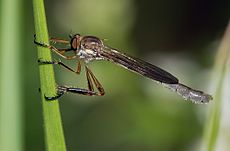Species Interactions

Prey
Omus californicus is a carnivorous beetle during the larval and adult stages of development (Pearson et al. 2001). The success and survival rates for the tiger beetle are dependent on the amount of food available which can limit population growth, while food shortage can also stunt or prolong development of the larvae (Kinsley and Juliano 1988; Brust et al. 2012). During the larval stages of development, the larva wait near the entrance of the burrow for passing organisms in the daytime as well as the night, and quickly snatch and drag the prey back into the burrow; these organisms are commonly small arthropods (Kinsley and Juliano 1988; Pearson and Vogler 2001). Once reaching adulthood, these nocturnal tiger beetles are found on the ground during cloudy days or night in search of prey (Pearson and Vogler 2001).
This organisms is highly predacious (Pearson et al. 1988), and the diet of the California Night-stalking Tiger Beetle typically includes mealworms, fruit flies, maggots, ants and other small insects (Spomer et al. 2008; Carvalho et al. 2014). Termites have also been found to be a nutritious food source for tiger beetles including Omus californicus (Brust et al. 2012). However, the diet of the Omus californicus depends heavily upon what organisms are available and are therefore known as opportunistic feeders (Carvalho et al 2014). This tiger beetle grasps its prey with the large, powerful mandibles protruding from the head of the organism (Pearson and Vogler 2001). To consume an organism, the mandibles contain glands that secrete enzymes to begin to break down the prey’s exterior; this enzymatic secretion is also used as a chemical defense when attacked by predators (Pearson and Vogler 2001). Following the secretion, Omus californicus devours the prey with the grinding motion of the back teeth entering more enzymatic fluid present in the tiger beetle’s midgut and then regurgitates the unusable remnants of the previously eaten prey. (Pearson and Vogler 2001).
The California Night-stalking Tiger Beetle is prey to several
predators as well. The most common predators to this organism
include lizards (Northern
California Alligator Lizard), birds, dragon flies,
long-tailed weasels, robber flies, and small
invertebrates (Pearson et al. 1988; Spomer et al. 2006). To try and
evade these predators, this selective force has resulted in a defensive
chemical compound known as benzaldehyde. This chemical is seen in other carabid
beetles, which is a secretion product from the pygidial gland
commonly seen in other arthropods unrelated in ancestry (Pearson et
al. 1988; Vogler and Kelley 1998). The genus Omus is one the most
primitive groups of tiger beetles (Pearson et al. 1988) and do not
secrete the compound known as benzaldehyde; however, the defensive
secretion found in most organisms contained in the genus Omus, is
the chemical phenylacetic acid (Vogler and Kelley 1998). This
chemical is derived from another known chemical, mandelonitile, to
ward off predators; although this secretion has little effect on
vertebrates (Pearson et al. 1988). This chemical compound is found
in the adult form of the California Night-stalking Tiger Beetle,
whereas the larvae have few defenses against predators. The larvae
typically retreat to the rear of the burrow tunnel to avoid
predators (Pearson and Vogler 2001). Other defenses for this tiger
beetle includes camouflage coloration of the black pigmentation to
ensure protection during nocturnal hours (Pearson et al.
2005).
Omus californicus and other carabid beetles play a vital role
in the food web of ecosystems. As an organism that preys upon many
other small arthropods, the California Night-stalking Tiger Beetles
have been used to control such pests (Carvalho et al 2014). The role
of this organism within ecosystems can help to regulate pest
populations ultimately diminishing the need for chemical
reinforcement (Carvalho et al 2014).
Page Created by Alex Marquardt
